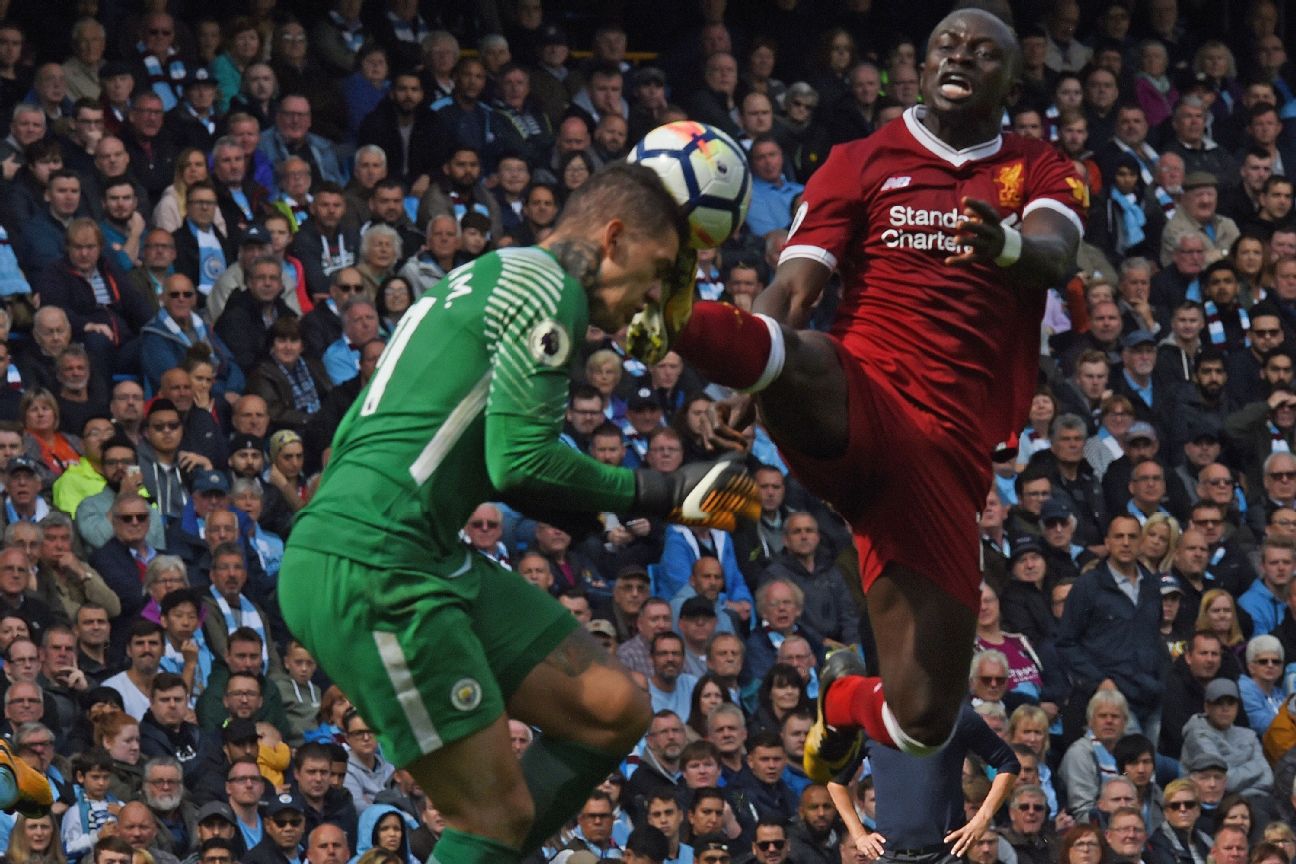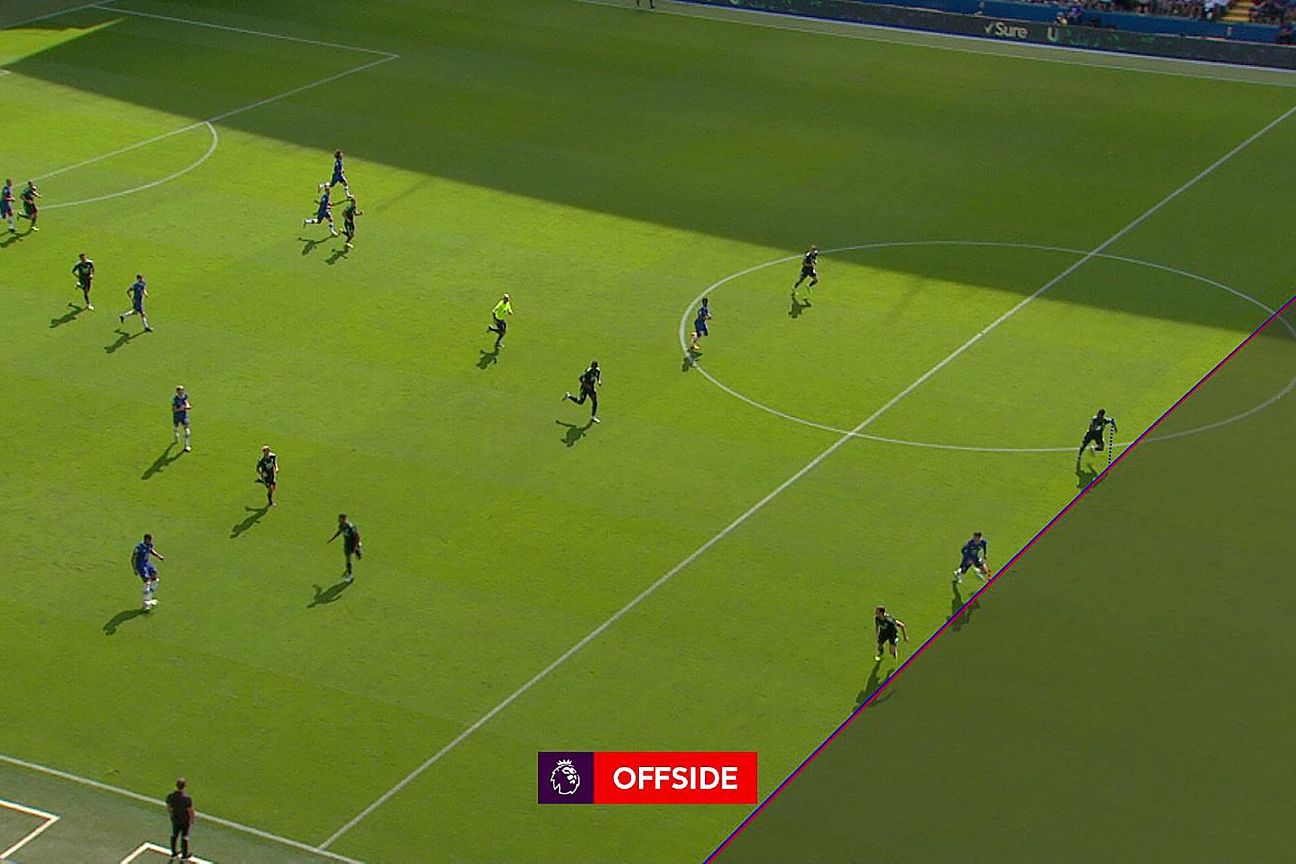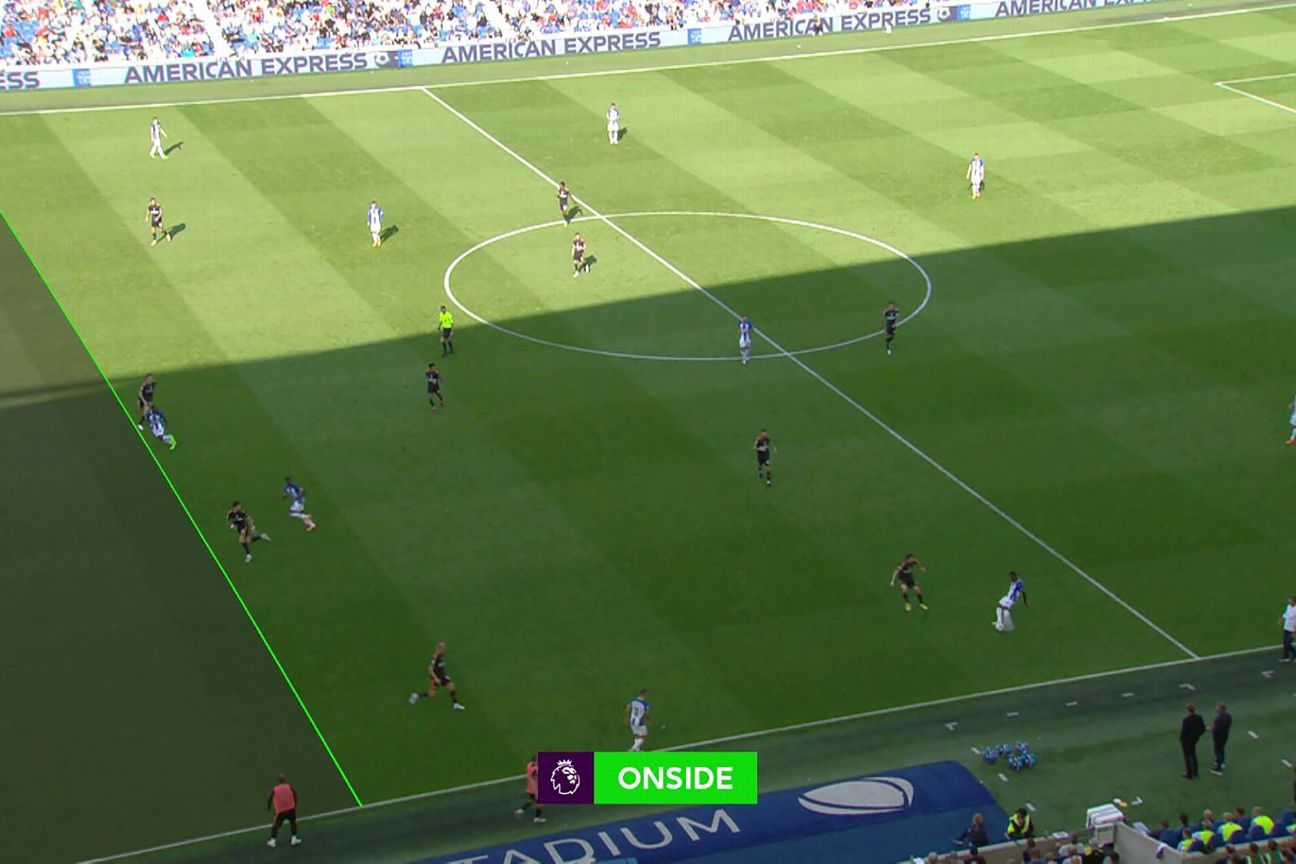
Video Assistant Referee causes controversy every week in the Premier League, but how are decisions made, and are they correct?
After each weekend we take a look at the major incidents, to examine and explain the process both in terms of VAR protocol and the Laws of the Game.
– How VAR decisions affected every Prem club in 2022-23
– VAR’s wildest moments: Alisson’s two red cards in one game
– VAR in the Premier League: Ultimate guide
JUMP TO: Man City vs. Palace | Chelsea vs. Leicester | Arsenal vs. Fulham | Wolves vs. Newcastle | Forest vs. Spurs
Possible penalty: McTominay handball
What happened: In the 60th minute with Manchester United 1-0 up, Southampton forward Che Adams attempted to chest down a lofted pass to the edge of the area. The ball hit the arm of Scott McTominay but referee Andy Madley waved away appeals for a penalty.
VAR decision: No penalty.
VAR review: While the ball hit McTominay three times, there is only one possible handball offence — from the initial rebound off Adams’ chest onto the outstretched arm of the United midfielder.
As discussed in last week’s VAR Review, handball decisions will often come down to the subjectivity of the VAR. In the case of McTominay, Peter Bankes decided that the arm was not in an unnatural position for the player’s body movement as he battled for the ball with an opponent, hitting him from close range with no time to react.
If referee Madley had given a penalty on the field of play it might have been a different outcome, because the referee’s original decision always carries the most weight.
We shouldn’t be expecting penalties to be awarded at such close proximity, especially when the ball isn’t going towards goal and it hasn’t blocked a cross into the box. We don’t want to get back to where we were two years ago when almost every handball was being penalised.
That said, expectations have understandably been lowered by the VAR penalty awarded to Crystal Palace against Aston Villa last weekend, for handball against Lucas Digne. Even though Digne had his arm above his shoulder (which carries an additional risk in the laws), it was at close range and he had no chance to react. It isn’t a situation the VAR should have got involved in. Wrong VAR interventions shouldn’t continue because of it, and it was correct for the VAR not to get involved here.
Disallowed goal: Edouard challenge on Ederson
What happened: Crystal Palace thought they had gone 3-0 up when Jordan Ayew scored, but the referee had already blown his whistle for a foul by Odsonne Edouard on Ederson.
VAR decision: No VAR intervention possible.
VAR Review: As referee Darren England had blown his whistle before Ayew scored, the VAR has no recourse to award a goal. Play stops at the moment the referee blows and anything after that point cannot be reviewed. It would have been better for England to allow the ball to enter the goal before stopping play (see the Chelsea vs. Leicester section for more on this.)
It’s worth explaining the decision itself, as it confused many supporters.
Law 12 states than an indirect free kick should be awarded if a player:
– prevents the goalkeeper from releasing the ball from the hands or kicks or attempts to kick the ball when the goalkeeper is in the process of releasing it.
This is exactly the kind of situation the law is intended to cover. You cannot block the goalkeeper at the point he releases the ball — be that if he is throwing it or kicking it out of his hands. He must be allowed to complete the release.
Ederson hadn’t completed the release of the ball, so even if the referee had given the goal the VAR would have advised it should be disallowed. It’s was a simple decision.
Of course, people will ask when has the ball actually been released? It’s not specifically defined in the laws in terms of distance, but guidance to referees clearly states that a goalkeeper must be able to release the ball without being challenged. Edouard obviously made an attempt to play the ball as the goalkeeper was in the process of releasing it.
We have a perfect example of when the ball has been released from the 2018 Champions League. Karim Benzema scored when he blocked a throw by Loris Karius, and while the Real Madrid striker was close to the Liverpool goalkeeper, there is clear space and the opponent can legally block the ball.
VAR will continue to present situations which highlight the intricacies of the Laws of the Game. Last season, Aston Villa saw a Jacob Ramsey goal correctly disallowed when Leicester City goalkeeper Kasper Schmeichel had the ball under his control.
Most fans were not aware that by having one hand on the ball while it is on the ground means the goalkeeper cannot be challenged.
So, as of this point, it is against the Laws of the Game for Kasper Schmeichel to “be challenged by an opponent” because having one hand on the ball, which is on the ground, is deemed being in control of the ball.
Jacob Ramsey has to be penalised with a direct free-kick. pic.twitter.com/Q60SRFC1jq
— Dale Johnson (@DaleJohnsonESPN) December 6, 2021
Possible red card: Haaland challenge on Andersen
What happened: In the 34th minute with Palace 2-0 up, Erling Haaland caught Joachim Andersen on the side of the head with a high boot. Referee England gave a free kick but took no disciplinary action against Haaland.
VAR decision: No red card.
VAR Review: A caution for Haaland was the best outcome here, because the City striker’s challenge was reckless. It’s surprising that England didn’t produce a yellow card considering he had a very clear view of the incident.
Remembering that VAR cannot advise the referee to show a yellow card, it didn’t reach the threshold for a red. Haaland was not off the floor and out of control in his challenge, there was no force involved and Andersen was also stooping to head the ball.
It’s a very different to the red card Sadio Mane received against Manchester City in September 2017. The Liverpool striker was completely off the floor and jumping towards Ederson when he caught the City goalkeeper in the head with his studs, clearly endangering the safety of an opponent with force in the challenge.

VAR overturned penalty: Havertz offside in the build-up
What happened: Chelsea were awarded a penalty in the 12th minute when Youri Tielemans brought down Ruben Loftus-Cheek inside the area, but there was an offside check against Kai Havertz in the buildup.
VAR decision: Penalty cancelled and free kick awarded to Leicester for offside.
VAR review: We talked in detail last week about VAR offside, specifically the tolerance level that was added to give the attacker the benefit of the doubt. And this decision falls into that same discussion.
Last season we saw very few offside calls that fell right on the border of this tolerance level, but in the first few weeks of this campaign we have already seen several. They keep coming thick and fast.
If the lines for the attacker and defender are touching, the technology will automatically signal the attacker is within the tolerance level and indicate the decision should be onside. But if the lines don’t touch, then offside has to be given. And that’s exactly what happened to Havertz. The benefit of the doubt isn’t subjectively being given by the VAR; the technology automatically says when it falls within the tolerance level.
There’s a question of how far back the VAR went to give offside. With a subjective decision like a foul (see Wolves vs. Newcastle) the VAR has more licence to judge whether the offence has taken place in the attacking phase, but as offside is a factual decision the VAR is likely to review further back.

The Havertz offside is the closest we’ve seen, probably more so than Gabriel Jesus’ disallowed goal for Arsenal at AFC Bournemouth last weekend.

We saw an example of a player being within the tolerance level, or benefit of the doubt, for Brighton & Hove Albion’s winning goal at home to Leeds United.
– Why Rashford was onside, but Jesus and Toney offside
When a player is only onside due to the tolerance level, a single green line is shown to the defender and no line is displayed to the attacker.
Danny Welbeck was right on the border of offside when he collected a pass from Pervis Estupinan. It’s the second time this season Brighton have had a goal allowed due to tolerance level in favour of Welbeck, the other coming in their 2-1 victory over Manchester United at Old Trafford.

Disallowed goal: Barnes challenge on Mendy
What happened: Leicester thought they had taken the lead in the 34th minute through Daniel Amartey, but referee Paul Tierney disallowed the goal for a foul by Harvey Barnes on Edouard Mendy.
VAR decision: No goal.
VAR Review: Tierney did what Darren England failed to do in the Man City vs. Crystal Palace game — he waited for the ball to go into the goal before blowing his whistle so the VAR, Andre Marriner, had full recourse to assess the situation and could advise a goal should be awarded if the referee had made a clear and obvious error.
It was a soft free kick, but given Barnes had his arm around the Chelsea goalkeeper as he was about to jump there was little chance the VAR would suggest there had been a mistake by Tierney.
There’s a high chance the goal would have counted had the referee not given the free kick on the field.
Possible handball: Saliba in the build-up to Gabriel’s goal
What happened: Arsenal scored their winning goal in the 86th minute when Gabriel forced the ball home following a corner. There was a question of handball and offside.
VAR decision: Goal stands.
VAR review: Any question of offside against Gabriel was quickly cleared up before looking at a handball against William Saliba.
As Saliba did not score the goal, he cannot be penalised for accidental attacking handball. That applies only to the goal scorer, after a change to the law in June 2021.
So the VAR’s only decision is whether Saliba deliberately handled the ball or his arm wasn’t in an expected position for his body movement. As he was jumping for the ball with an opponent this wouldn’t be considered a handball offence.
Possible penalty: Foul by Nunes on Longstaff
What happened: In the 11th minute Wolverhampton Wanderers’ Matheus Nunes held onto the shirt and arm of Newcastle United’s Sean Longstaff just inside the area. Referee Peter Bankes allowed play to continue.
VAR decision: No penalty.
VAR review: At the start of the season the Premier League said it wanted to clamp down on pulling and grappling inside the box, and set out guidelines for how referees would judge offences.
The act of holding or pulling a shirt or opponent alone won’t be considered an offence, there must be a material consequence of that contact. So, we’re looking for sustained holding that prevents a player from having the opportunity to play or challenge for the ball
Key considerations include:
– if the opponent is paying no attention to challenging for the ball
– if the pulling or holding clearly prevents movement and the ability to challenge for the ball
Nunes had no intention of playing the ball, but perhaps there is a question over the impact the shirt tug had on Longstaff. When watching the incident at full speed, without using a slow-motion replay, there isn’t any prolonged holding and that is why VAR Lee Mason didn’t advise a penalty kick.
However, it’s the kind of decision fans will struggle to get on board with. When the shirt comes away from the body, or the opponent’s arm is being held, there is an expectation that this should be punished with a penalty kick. We’ll watch with interest for similar incidents as the season progresses.
Possible red card: Foul by Schar on Neto
What happened: In the 46th minute, Fabian Schar caught Pedro Neto high above the ankle. Referee Bankes showed the yellow card and there was a review for a red.
VAR decision: No red card.
VAR review: We will discuss this kind of challenge almost every week, with a player making contact with an opponent above the ankle. What turns a card from yellow to red is usually the force and intensity of the challenge. Schar’s tackle was poor, and it being so high above the ankle ran a very real risk of being a red card.
In other leagues with a lower threshold for intervention, the referee might well have been sent to the monitor to have another look. VAR Mason decided that a yellow card was a justifiable disciplinary outcome.
Goal disallowed: Foul on Fraser by Neto
What happened: Wolves thought they had a second goal in the 82nd minute when Neto set up Raul Jimenez to score from close range, but the VAR looked at a foul in the buildup.
VAR decision: Goal disallowed.
VAR review: Neto directly created the goal from the challenge, starting a fast counter-attack from just inside his own half to cross for Jimenez to score. The foul at the start of the attacking phase created the possession for Neto to assist the goal.
It’s a fine line for VAR in the Premier League. Most people will accept this was a foul by Neto, but will we see consistency for other such challenges before a goal is scored?
Possible red card: Handball by Cook
What happened: Tottenham Hotspur were awarded a penalty in the 54th minute for handball against Steve Cook. The Nottingham Forest defender was booked by referee Craig Pawson.
VAR decision: No red card.
VAR review: The question for the VAR, Stuart Attwell, wasn’t whether the penalty should stand, but if Cook should be sent off for denying an obvious goal-scoring opportunity.
The VAR isn’t asking himself will Harry Kane head the ball, but does the Spurs striker have a realistic chance of scoring a goal. The England captain was already arching backwards in anticipation of the ball coming to him, so there had to be an element of doubt that he would be able to control the header and get an effort on target. For that reason, the yellow card is an acceptable decision.
Information provided by the Premier League and PGMOL was used in this story.
